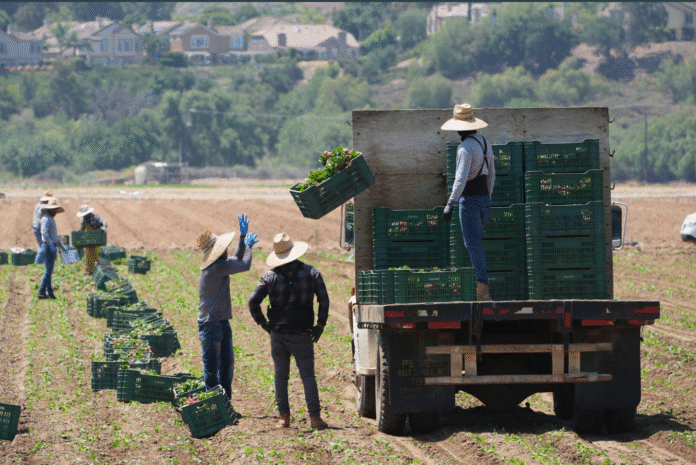Immigration Policies Impact Economy: Prices Surge and Workers Vanish
The immigration policies impact economy debate in the United States is intensifying as new data shows alarming consequences of mass deportations and tariffs. From skyrocketing wholesale vegetable prices to shrinking workforces in key industries, experts warn that President Donald Trump’s hardline immigration agenda could destabilize not just agriculture but also construction, hospitality, and manufacturing.
According to the Bureau of Labor Statistics, wholesale vegetable prices surged by 38.9% between June and July 2025, the steepest rise in more than three years. Economists argue that labor shortages, compounded by tariffs, drought, and wildfires, are amplifying the crisis and leaving both businesses and consumers paying the price.
How Deportations Are Affecting Agriculture
One of the clearest ways immigration policies impact economy is in agriculture. With deportation raids accelerating, thousands of immigrant farmworkers have disappeared from the fields.
Phil Kafarakis, president of the International Food Away From Home Association, warns:
“You are now going to be left with not enough laborers in the fields to pick up and collect product as it’s coming to harvest.”
This shortage is not just driving up prices at the farm level but also threatening supplies in grocery stores, restaurants, and food services across the country. Combined with natural disasters like flooding and wildfires, the deportation push is worsening an already fragile supply chain.
Texas: A Case Study in Economic Slowdown
Texas offers a vivid example of how immigration policies impact economy at the state level. The Dallas Federal Reserve recently reported that the Texas economy has softened, with business owners blaming tariffs and immigration enforcement for investment slowdowns.

The bank’s survey found:
-
Firms are struggling to hire and retain workers.
-
Many immigrant workers who previously fueled industries like manufacturing and construction are no longer available.
-
Uncertainty over future policy is preventing expansion.
A Texas machine manufacturer summed it up:
“Foreign-born laborers get the job done. We need them, we use them, and we like them.”
Fewer Immigrant Workers = Higher Prices
Data backs up the claim that fewer workers are hitting the U.S. economy. According to the National Foundation for American Policy, the foreign-born workforce shrank by 1.2 million between January and July 2025. Yet there has not been a matching rise in native-born Americans filling those roles.
When employers cannot hire, they invest less—leading to slower growth. Industries like construction, food service, and hospitality, where immigrant workers are essential, are already feeling the pressure.
The Ripple Effect Across Industries
Agriculture
From strawberries in California to vegetable farms in Texas, crops risk going unharvested due to labor shortages.
Construction
In states with the highest number of unauthorized workers, construction employment fell 0.1%, while other states saw a modest increase.
Hospitality & Restaurants
Roughly 7% of workers in leisure and hospitality are undocumented. In states heavily reliant on them, job growth slowed to 0.2%, compared to 1.5% in others.
This slowdown translates to fewer restaurant staff, longer wait times, and higher prices for consumers.
Immigration Crackdowns and Workforce Fear
The human toll is also visible. United Farm Workers (UFW) spokesman Antonio De Loera-Burst described how raids are creating panic among agricultural workers:
“Workers are frightened. Hours are being cut, and workers are told to do in six hours what they used to do in eight.”
He also argued that some growers may be leveraging these raids to push for more guest worker programs that allow them to pay lower wages.

Advocacy Groups Warn of Lasting Damage
A report from America’s Voice and researchers at Washington College and the University of New Hampshire warns that the country is losing workers without replacement. They argue that:
-
Employment in agriculture dropped by 155,000 workers this summer compared to last year.
-
Worker cycling in and out of the U.S. has effectively stopped due to border restrictions.
-
Economic consequences are spreading beyond farms into retail, restaurants, and logistics.
This shows how immigration policies impact economy not just at the borders, but in everyday consumer costs.
What’s Next for Trump’s Policy?
President Trump has faced pressure from business leaders in agriculture and hospitality, demanding a reliable workforce. Initially, raids were paused in these industries, but later resumed. Trump has since floated the idea of temporary work passes for certain laborers, though no concrete plan has emerged.
Until then, industries that rely on immigrant workers are left in limbo, and Americans are already feeling the impact at grocery stores and restaurants.
Conclusion
The evidence is mounting: immigration policies impact economy in ways that touch every American household. From the cost of vegetables to the availability of hotel staff, industries that rely on immigrant labor are straining under deportations and tariffs.
As policymakers debate, the reality for businesses and consumers is clear, labor shortages drive up costs, slow down growth, and limit opportunities. Whether temporary worker programs or new policies emerge, the months ahead will determine how deeply these impacts reshape the American economy.

